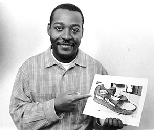CAMBRIDGE, MA--Like many 16-year-olds, Ronald S. Demon spent hours honing his basketball skills. Like many basketball players, Ronald's feet would ache after a hard day on the hardwood. Unlike his peers and their elders, he had the imagination, know-how and skills to do something about it.
Ronald Demon of Miami, FL, now a senior at MIT majoring in electrical engineering and computer science, designed an all-purpose shoe that automatically adapts to the wearer's needs, adjusting the cushion to suit the pace of the activity in which he or she is engaged.
He started by developing a software program at his family's home in Miami. After that he moved the project to Palmetto High School and eventually worked on a prototype at the Florida International University Technical Resources Center.
The process took five years. On Sept.������������������29, patent number 5,813,142 was issued to Ronald Demon for a "shoe sole with an adjustable support pattern."
Mr. Demon believed Reebok's hype of its big breakthrough several years ago -- shoes equipped with an air pump that needed to be used each time he wore them. But it didn't work for him. "I really hated pumping them up," he said. He also remembers shoes with fluid departments beneath the heel and others with air-filled cells.
Mr. Demon's invention is described simply and succinctly in the patent papers: "The invention relates generally to a shoe having an adjustable support-pattern and more specifically to a shoe that selectively measures and adjusts the pressure in a number of zones beneath the user's foot as the user's foot impacts the traveling surface."
The harder the user is working, the softer the cushion. Adjustments are made by sensors which regulate the flow of fluid from strategically placed bladders to adjust the cushion.
The original prototype is at home in Miami. They are size 9 1/2, a perfect fit for Mr. Demon, who has tested them walking and running. "I didn't play basketball," said Mr.������������������Demon, who wants to refine the model by making the pieces smaller and more durable and integrating them better before testing the marketplace.
Another prototype is in the works at the Edgerton Center at MIT ("It's just a mess of wires now," he said). When it is completed in January, Mr. Demon hopes to persuade MIT runners, basketball players and other athletes to put them to the test. "We'll push them to the limit," he said.
After graduation, Mr. Demon plans to attend graduate school, possibly at MIT. The only child of an accountant and an educator, he chose to attend MIT as an undergraduate over Princeton, Cornell, Georgia Tech, Northwestern and Carnegie-Mellon. It was an easy call.
"I'm a software guy," said Mr. Demon, adding that his parents are technologically challenged, "and MIT was the best place for a software guy to be."
Mr. Demon does not have much time to play basketball nowadays. Honing patent number 5,813,142 takes precedence over his jump������������������shot.
Take it away, Reebok and Nike. But it'll cost.






